Quick Question: What Is The Flavor Of Grandma’s Chicken Noodle Soup?
“Grandma’s Chicken Noodle Soup” can have a nostalgic and comforting flavor profile, often characterized by a combination of savory, aromatic, and wholesome tastes. While flavors can vary based on individual recipes and personal touches.
Most of us turn to chicken noodle soup whenever we get sick, but no chicken noodle soup hits the same way as when grandma made it. So, here’s a fantastic grandma’s chicken noodle soup recipe for you to try out!
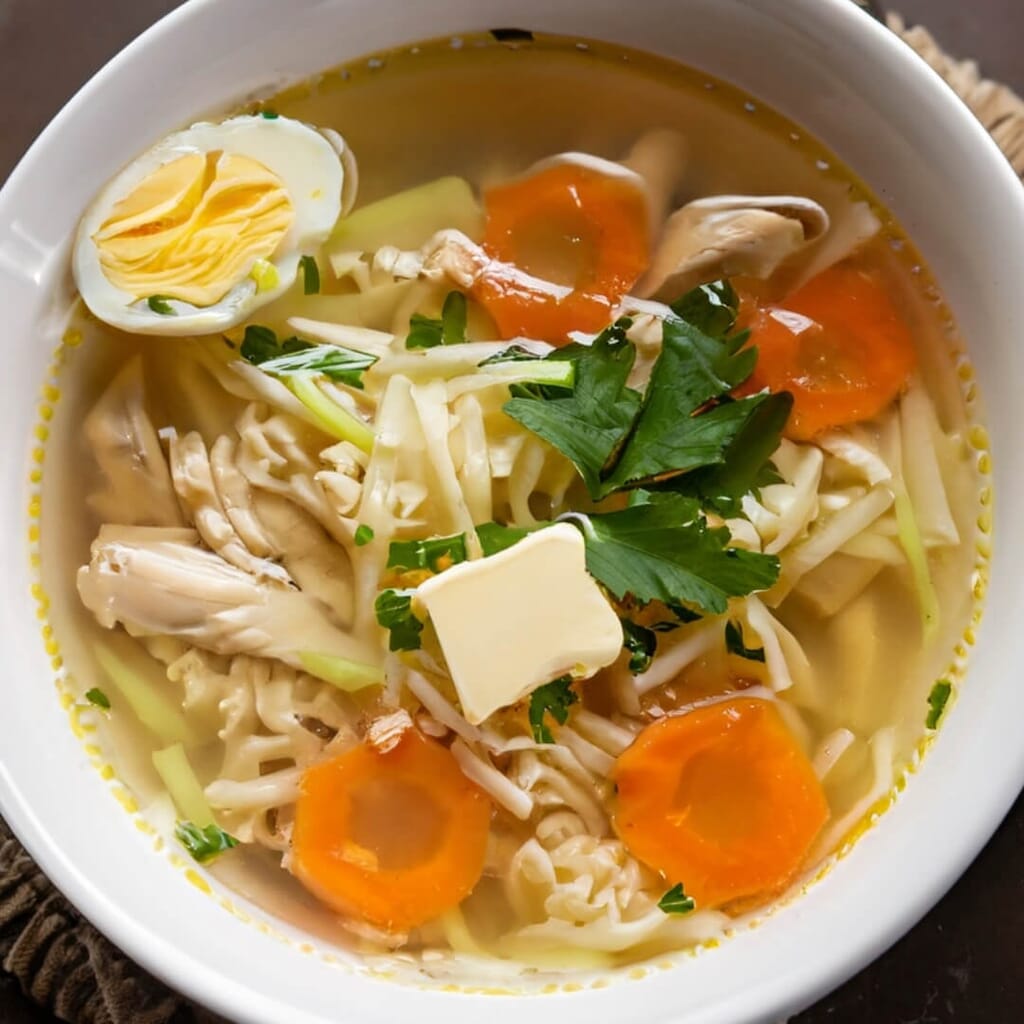
Chicken noodle soup is a classic favorite soup around the world. Many love a bowl or two whenever they need a pick-me-up, as this is a great comfort food.
Many of us loved this soup throughout childhood – so how can you get that same feeling now you are an adult and cooking for yourself?
This is the place for you if you are after a nostalgic chicken noodle soup recipe. We have assembled a chicken noodle soup recipe with all the Southern touches needed to make it taste extra special.
What Is Chicken Noodle Soup?
Chicken noodle soup is considered a comfort food for those feeling sick or unwell. It is super tasty, filling, and packed with important nutrients and vitamins that can help you return to your normal self.
This is thanks to all the vegetables in classic chicken noodle soup recipes. Plus, it’s low in calories because it uses chicken instead of red meats, so it’s a healthy soup.
Chicken noodle soup is also affordable, as it uses many ingredients you likely already have in your kitchen. If you have any leftover chicken, vegetables, or noodles, you need to use up – it goes into the pot!
Most of us have eaten chicken noodle soup; for most people, it’s a nostalgic dish they strongly tie to their grandparents and childhood.
It’s a hearty, delicious hot soup that most of us start to crave when we are under the weather – and one we need to learn to make ourselves once we are adults!
So, check out the guide below to learn how to make chicken noodle soup, just as Grandma used to make it!
History Of Chicken Noodle Soup
Chicken noodle soup’s origins span cultures and centuries. Ancient China and Greece both celebrated broths with fowl and noodles or grains. By the Middle Ages, the healing properties of chicken broth were widely acknowledged in Europe.
As European immigrants settled in America, they merged their culinary traditions. When packaged noodles became accessible in the 20th century, the modern “chicken noodle soup” took shape. Today, it is both a remedy for the sick and a comfort for the soul.
Interesting Facts About The Chicken Noodle Soup
- Global Roots: It’s embraced in various forms across continents – from Jewish penicillin to China’s chicken broths.
- World Record: The largest pot of chicken noodle soup weighed over 1,000 pounds!
- War Boost: During World War II, condensed chicken noodle soup was introduced as an easily transportable food.
- Weather Forecast: The sales of chicken noodle soup significantly rise during colder months.
- Medical Marvel: Some studies suggest the soup may reduce inflammatory agents responsible for symptoms of colds.
- Movie Mention: It’s referenced in classic films like “It’s a Wonderful Life.”
- Noodle Shapes: While many favor long, thin noodles, diverse cultures use varied shapes and sizes.
What Makes The Chicken Noodle Soup Special?
- Universal Comfort: Almost every culture has its version, making it globally cherished.
- Healing Properties: Often dubbed “nature’s penicillin,” it’s a go-to for colds and flu.
- Simplicity: Basic ingredients come together to create rich, profound flavors.
- Memories: It evokes feelings of home, childhood, and care.
- Versatility: Suitable for both an everyday meal and special gatherings.
- Wholesomeness: Balanced with protein, carbs, and veggies.
- Timelessness: Its appeal spans generations, never going out of culinary fashion.
- Quick Preparation: Easy to whip up, especially with modern shortcuts.
- Dietary Flexibility: Can be adapted for various dietary needs.
- Culinary Canvas: It’s a base that chefs can experiment with, adding unique twists.
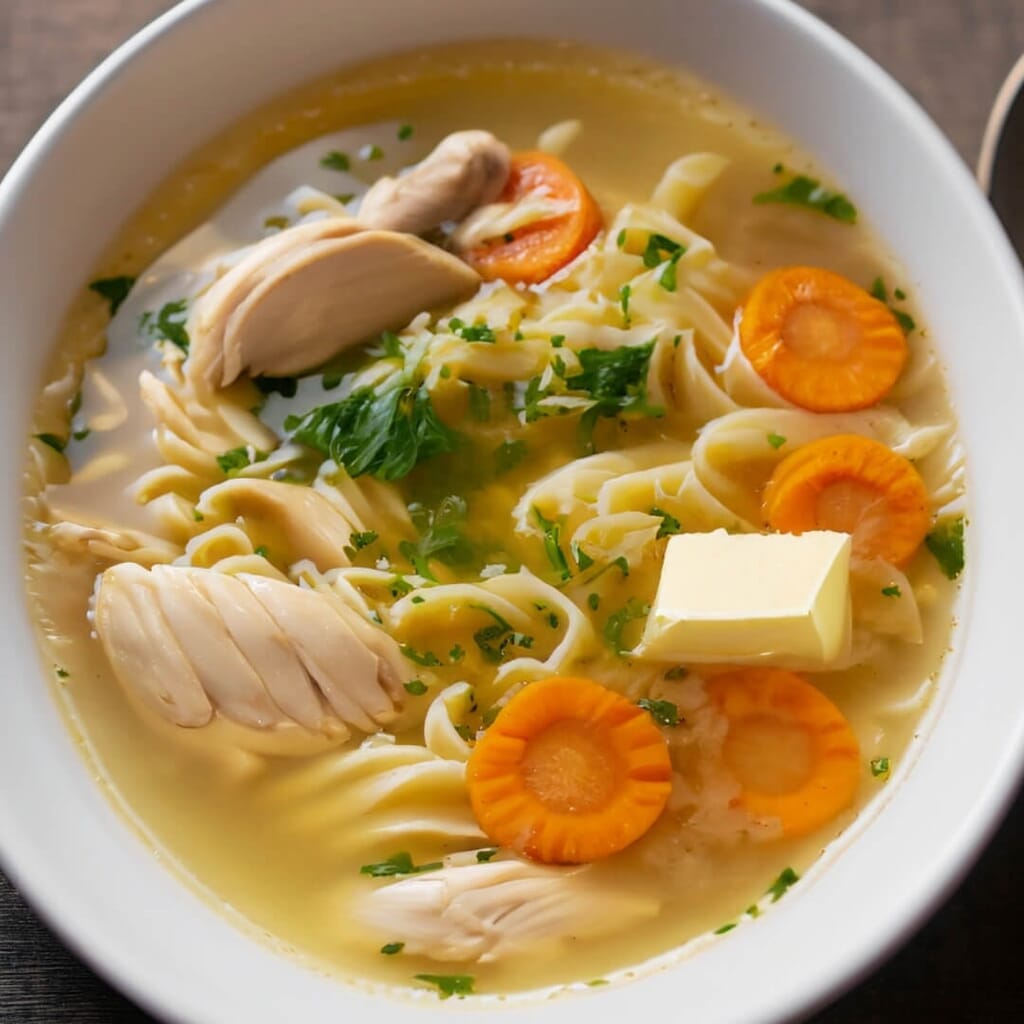
Ingredients List
| Ingredient | Quantity |
| Chicken | 2 chicken breasts or 4 chicken thighs |
| Chicken Broth | 4 cups (1 liter) |
| Water | 2 cups (500 ml) |
| Egg Noodles | 2 cups |
| Carrots | 2 medium, sliced |
| Onions | 1 large, diced |
| Celery | 2 stalks, sliced |
| Garlic | 3 cloves, minced |
| Herbs | 2 tsp (thyme, rosemary or bay leaves) |
| Seasoning | Salt and pepper to taste |
| Butter | 2 tablespoons |
Ingredients Needed For Making The Soup
Chicken
- Of course, you will need chicken in a chicken noodle soup! This recipe’s best type of chicken is boneless, skinless chicken breasts. They are easy to chop up or shred (whichever method you prefer) and cook well in your soup!
Chicken Broth
- 4 cups of chicken broth or chicken stock is included to give your soup plenty of liquid, so it has the right consistency.
Water
- As well as the 4 cups of chicken broth, you will need 1 ½ cups of water if you make your chicken noodle soup in a slow cooker. If not, add it to the chicken broth!
Egg Noodles
- Another key ingredient in chicken noodle soup is, of course, the noodles! 8 ounces of dry egg noodles is just what you need for grandma’s version of chicken noodle soup!
Carrots
- One of the reasons why chicken noodle soup is a great food option when you are sick is because it’s packed with nutrients. This is thanks to all the veggies it has in its recipe, and one of the most important is carrots!
- For this recipe, you must peel and dice up a medium carrot. Measure out 1 cup of diced carrot and add it to the soup!
Onions
- Another great vegetable used in Grandma’s chicken noodle soup is onions. Onions bring a nice tender texture to the soup and a unique flavor that’s all its own. For this recipe, you will need ½ of a medium onion, peeled and diced and ready to cook!
Celery
- Celery is a great way to make a soup more filling without piling on the calories. Plus, it’s packed with vitamins and minerals to help you feel better – so add 1 cup of diced celery (usually around 3 medium celery stalks) to your soup!
Garlic
- Garlic is often added to all kinds of dishes to help enhance the flavor and make it more aromatic.
- So, seeing it in grandma’s chicken noodle soup is no surprise! You only need a teaspoon of minced garlic to boost that aroma and flavor!
Herbs
- Adding herbs to your soup is another great way to make it more aromatic and flavorful. In this recipe, we added rosemary and thyme to give it a nostalgic aroma. How much you need depends on whether you use dried or fresh herbs.
- If you use fresh herbs, you will need a tablespoon of finely chopped rosemary and a tablespoon of freshly chopped thyme. If you use dried herbs, then a teaspoon of each herb is all you need.
Seasoning
- A teaspoon of salt and pepper are added to help season the chicken.
Butter
- A tablespoon of butter is needed to help you saute your vegetables. However, if you use a slow cooker to make your soup, you need to coat the cooker with some non-stick cooking spray.
Ingredient Tips
- Chicken: Opt for bone-in pieces; they lend a deeper flavor.
- Broth: Homemade is best, but store-bought can be enriched with simmered veggies.
- Water: Always use cold water to start for clarity.
- Egg Noodles: Opt for whole grain for added nutrition.
- Carrots: Younger, smaller carrots often have a sweeter flavor.
- Onions: Yellow onions give a rich, traditional taste.
- Celery: Use leaves, too; they’re flavor-packed.
- Garlic: Freshly minced offers a punchier flavor than jarred.
- Herbs: Fresh herbs infuse a brighter taste than dried ones.
- Butter: Use unsalted to control the sodium content.
Can You Vary The Recipe With Other Ingredients?
- Keto: Replace noodles with zucchini noodles (“zoodles”) and increase the chicken or add high-fat ingredients like avocado.
- Paleo: Use grain-free noodles like spiralized vegetables, and ensure your broth is free from additives and preservatives.
- Gluten-Free: Opt for gluten-free noodles, like rice noodles or gluten-free pasta, ensuring the broth is also gluten-free.
- Whole30: Use compliant chicken broth, replace noodles with vegetable spirals, and avoid non-compliant additives.
- Vegetarian: Omit chicken and use a hearty vegetable broth. Add mushrooms or tofu for more substance.
- Vegan: Alongside omitting chicken and using vegetable broth, consider adding beans, lentils, or chickpeas for protein and texture.
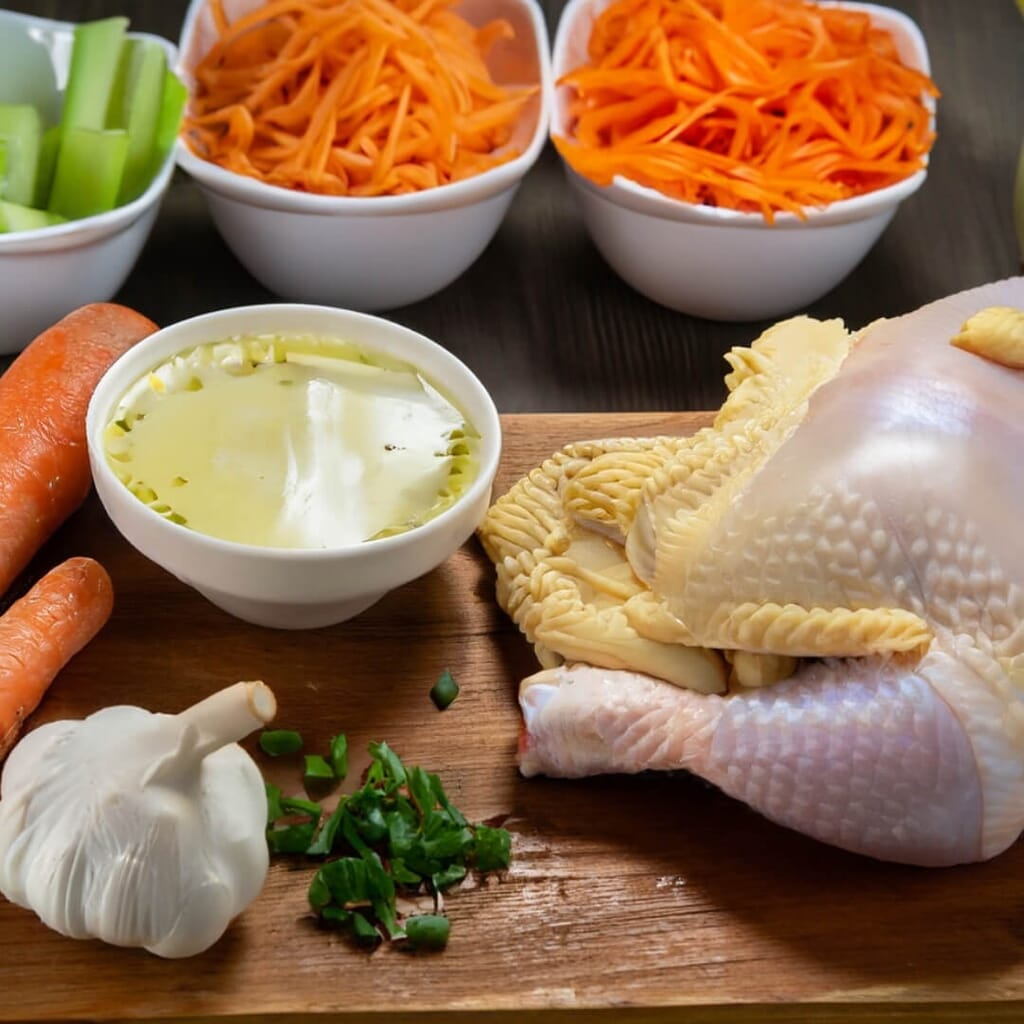
Recipe Directions
- Sauté Base Ingredients: Melt the butter in a large pot over medium heat. Add the onions and celery, sautéing until tender, about 5 minutes.
- Add Main Ingredients: Introduce chicken, noodles, carrots, garlic, seasonings, and herbs to the pot. Stir well, ensuring an even distribution of ingredients.
- Pour Liquids: Add chicken broth and water. Mix well.
- Bring to Boil: Increase the heat to bring the mixture to a boil.
- Simmer: Once boiling, reduce the heat to low, cover the pot, and let the soup simmer for 20 minutes. This allows the flavors to meld and the chicken and noodles to cook thoroughly.
- Serve and Enjoy: After simmering, do a taste test and adjust seasonings if needed. Ladle the soup into bowls, garnish with fresh herbs if desired, and serve hot. Enjoy your comforting bowl of chicken noodle soup!
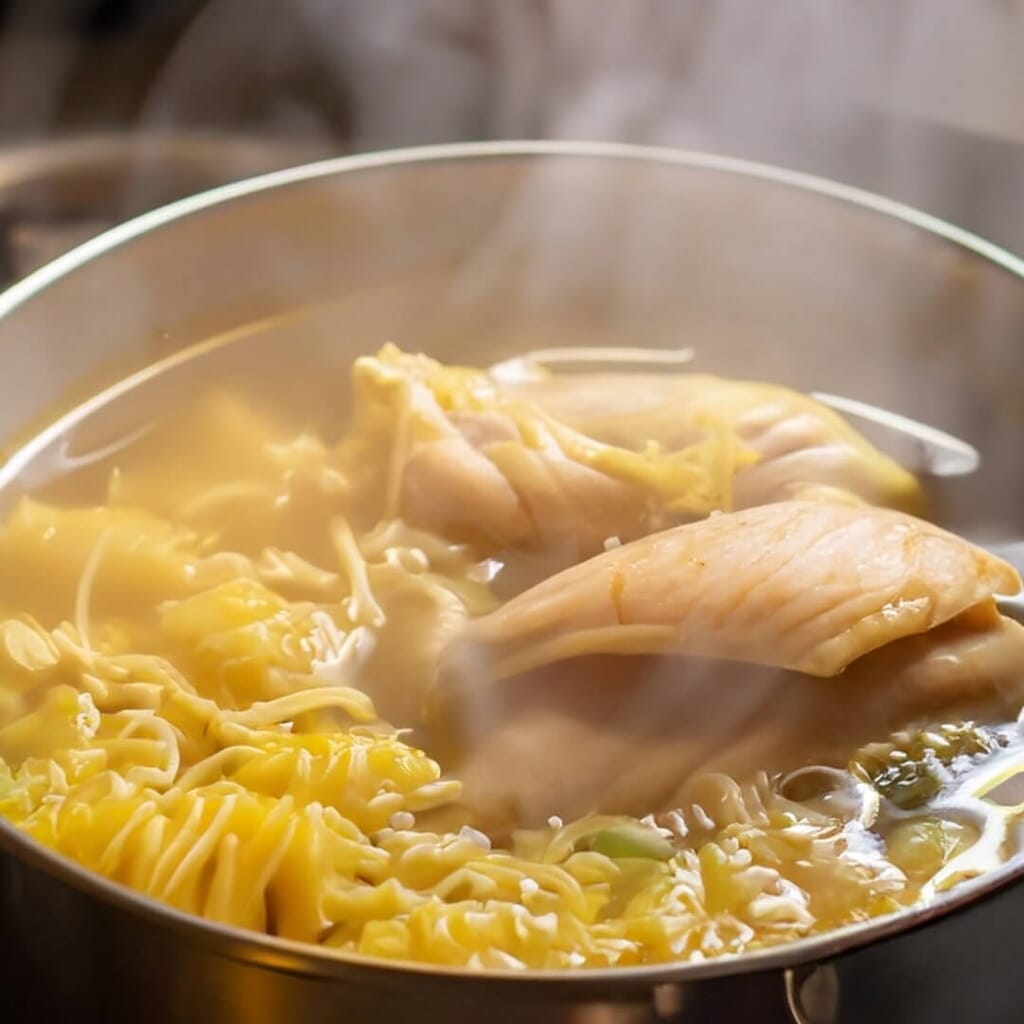
Variations, Add-Ons, And Toppings
Variations
- Asian Twist: Incorporate ginger, lemongrass, and switch to rice noodles.
- Creamy Version: Add heavy cream or coconut milk for a rich texture.
Add-Ons
- Grains: Quinoa, barley, or rice can offer a hearty twist.
- Protein Boost: Include chickpeas, lentils, or tofu.
- Greens: Spinach, kale, or bok choy enhance nutritional value.
Toppings
- Herbs: Fresh parsley, dill, or cilantro add flavor.
- Spice: A sprinkle of red chili flakes or a dash of hot sauce can elevate heat.
- Texture: Croutons, toasted sesame seeds, or fried onion bits provide a crunch.
- Zest: A squeeze of lemon or lime juice brightens up flavors.
- Cheese: Grated Parmesan or a dollop of sour cream for creaminess.
Scaling The Recipe
- Mathematics: Start by determining the scaling factor. If you want to double the servings, multiply every ingredient by 2. For half, divide by 2.
- Pot Size: Ensure your cooking vessel can accommodate the scaled quantity. Overcrowding may affect cooking times.
- Consistency: For soups, consistency is crucial. When scaling up, add liquids gradually to achieve the desired thickness.
- Cooking Times: While ingredient amounts change, cooking times may not double or halve precisely. Monitor closely to avoid over or under-cooking.
- Spices and Seasonings: Be cautious. A direct multiplication or division might result in overly strong or weak flavors. Adjust to taste.
- Taste Test: Always taste the scaled recipe to ensure flavors are balanced. Adjust as needed.
What Is Used For Garnishing?
- Fresh Herbs: Parsley, cilantro, basil, dill, rosemary, and mint are popular choices.
- Citrus Zests and Slices: Lemon, lime, orange, or grapefruit can add color and freshness.
- Edible Flowers: Pansies, violets, and nasturtiums add color and a delicate flavor.
- Seeds and Nuts: Toasted sesame seeds, sunflower seeds, crushed nuts, and chia seeds.
- Grated Cheese: Parmesan, cheddar, or any other variety.
- Spices: Paprika, cinnamon, and ground pepper can add color and taste.
- Chopped Vegetables or Fruits: Bell peppers, tomatoes, strawberries, or kiwi slices.
- Drizzles: Olive oil, melted chocolate, caramel, or sauces.
- Croutons or Toasted Bread Slices: Particularly for soups or salads.
- Sprouts: Alfalfa, radish, or bean sprouts can give a fresh, earthy touch.
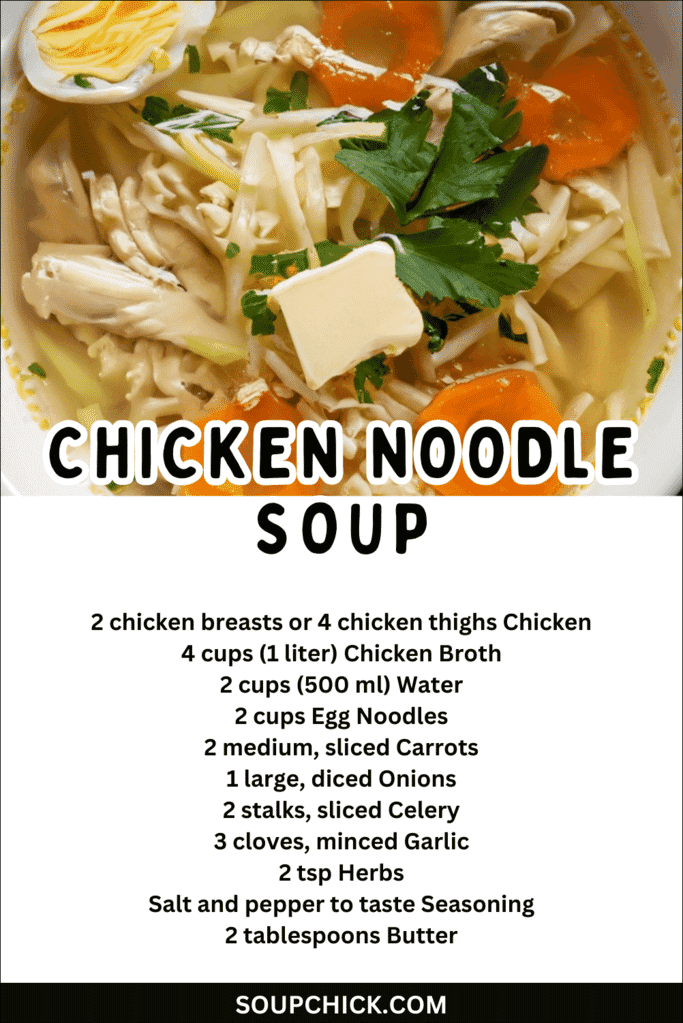
Can I Make Chicken Noodle Soup In A Slow Cooker Or Instant Pot?
Slow Cooker
- Many of us use slow cookers to make soups, stews, and broths these days, so how can you make grandma’s chicken noodle soup using a slow cooker? Here’s a recipe to help you out!
- Start by preparing your slow cooker. Spray it with non-stick cooking spray and add all ingredients apart from the egg noodles and water.
- It’s a good idea to first add the chicken breasts with the seasoning directly on top. Then add the vegetables and pour the chicken broth over the top. Stir well to mix everything and combine them well.
- Once that’s done, cover your slower cooker with the lid and allow it to cook on low heat for seven hours.
- After seven hours, go back and carefully remove the chicken breasts with some tongs. Shred the chicken breasts well and put them back into the pot using two forks. The chicken should be thoroughly cooked at this point.
- Then, add the egg noodles and pour the water over the top. This ensures the noodles are covered in liquid so they can cook.
- Put the lid back on your slow cooker and let it cook on high heat for 30 minutes. Check that the noodles are nice and tender and that the shredded chicken is thoroughly cooked before serving!
Instant Pot
- Use the “Sauté” function to cook onions and celery in butter. Add other ingredients except for the noodles. Seal and set to “Manual” or “Pressure Cook” for 7-8 minutes.
- Quick-release the pressure, open the lid, and set to “Sauté” again. Add noodles, cooking until tender. The Instant Pot offers a faster yet more flavorful soup.
Can I Use Store Bought Broth, Or Should I Make My Own?
Store-Bought Broth
- Convenience: Quick and easy, especially for impromptu meals.
- Consistency: Offers a predictable taste every time.
- Variety: Available in different flavors and dietary preferences (e.g., low-sodium, organic, bone broth).
- Shelf Life: Lasts longer when unopened; great for pantry stocking.
Homemade Broth
- Flavor Control: Customize according to personal preference.
- Freshness: Free from preservatives and additives.
- Economical: Make use of leftover chicken bones and veggie scraps.
- Nutrition: Often richer in nutrients and can be tailored for specific dietary needs
Can I Use Different Types Of Meat/Fish/Pasta/Vegetables For The Soup?
Meat/Fish
- Turkey: A great post-Thanksgiving choice, using leftovers.
- Beef: Opt for tender cuts or stewing chunks.
- Fish: Firm varieties like salmon or cod work best.
- Shrimp or Shellfish: Add these closer to the end to prevent overcooking.
Pasta
- Rice: Substitutes like wild or jasmine rice add texture.
- Whole Wheat/Grain Pasta: For added nutrition.
- Rice Noodles: Perfect for a gluten-free alternative.
Vegetables
- Mushrooms: Enhance the depth of flavor.
- Potatoes: Create a heartier soup.
- Leafy Greens: Spinach, kale, or chard for added nutrition.
- Bell Peppers: Give a sweet, crisp bite.
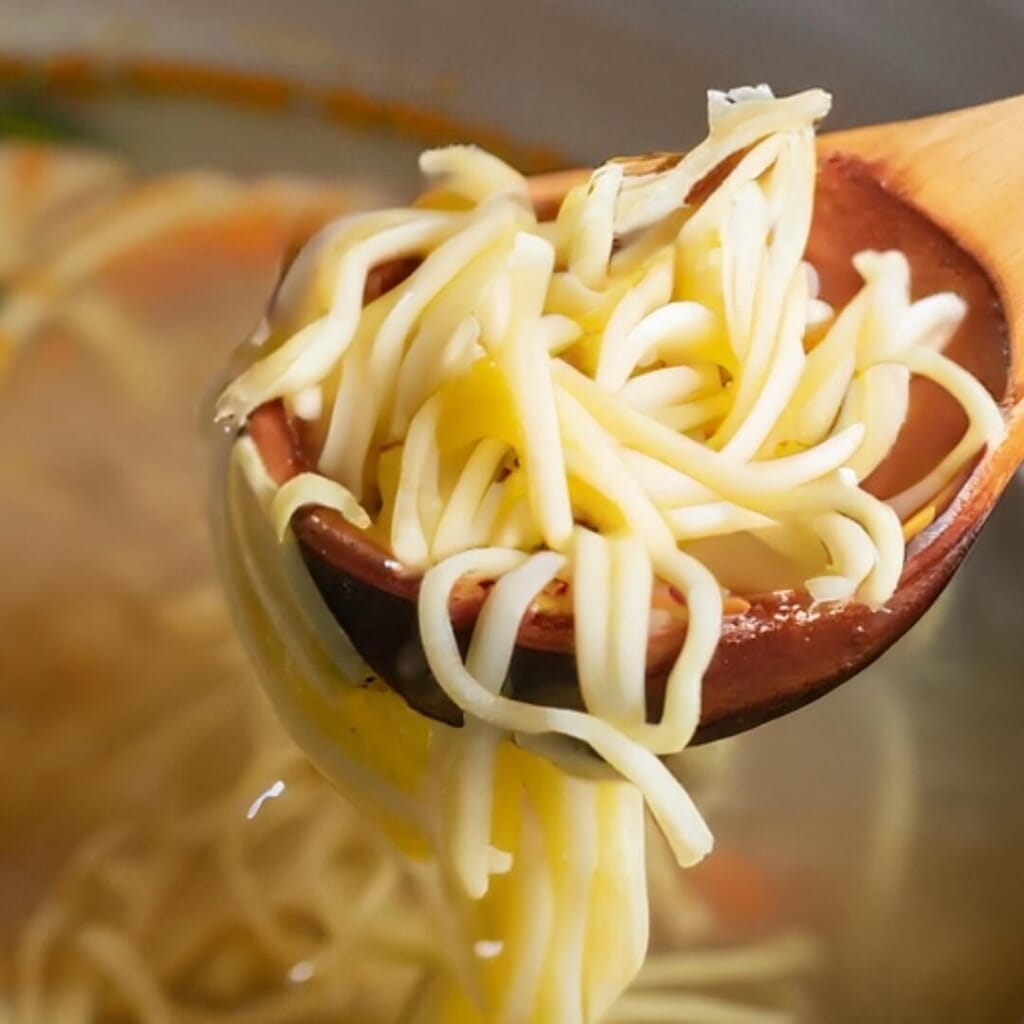
Success Tips – Tips And Tricks For Making The Soup
Tips and Tricks for Making Chicken Noodle Soup:
Prepping Tips
- Mise en Place: Have all ingredients chopped and measured before cooking.
- Broth Quality: For richer flavor, start with cold water when making homemade broth.
- Chicken Choice: Bone-in, skin-on pieces enhance depth.
- Fresh Herbs: Bundle them together for easy removal.
Cooking Time Tips
- Noodle Timing: Add noodles towards the end to prevent overcooking.
- Low and Slow: Simmer gently rather than boiling vigorously for the best flavors.
- Skimming: Occasionally skim the surface to remove impurities and fat.
- Taste as You Go: Adjust seasonings gradually throughout cooking.
- Rest Before Serving: Let soup sit a few minutes post-cooking to meld flavors.
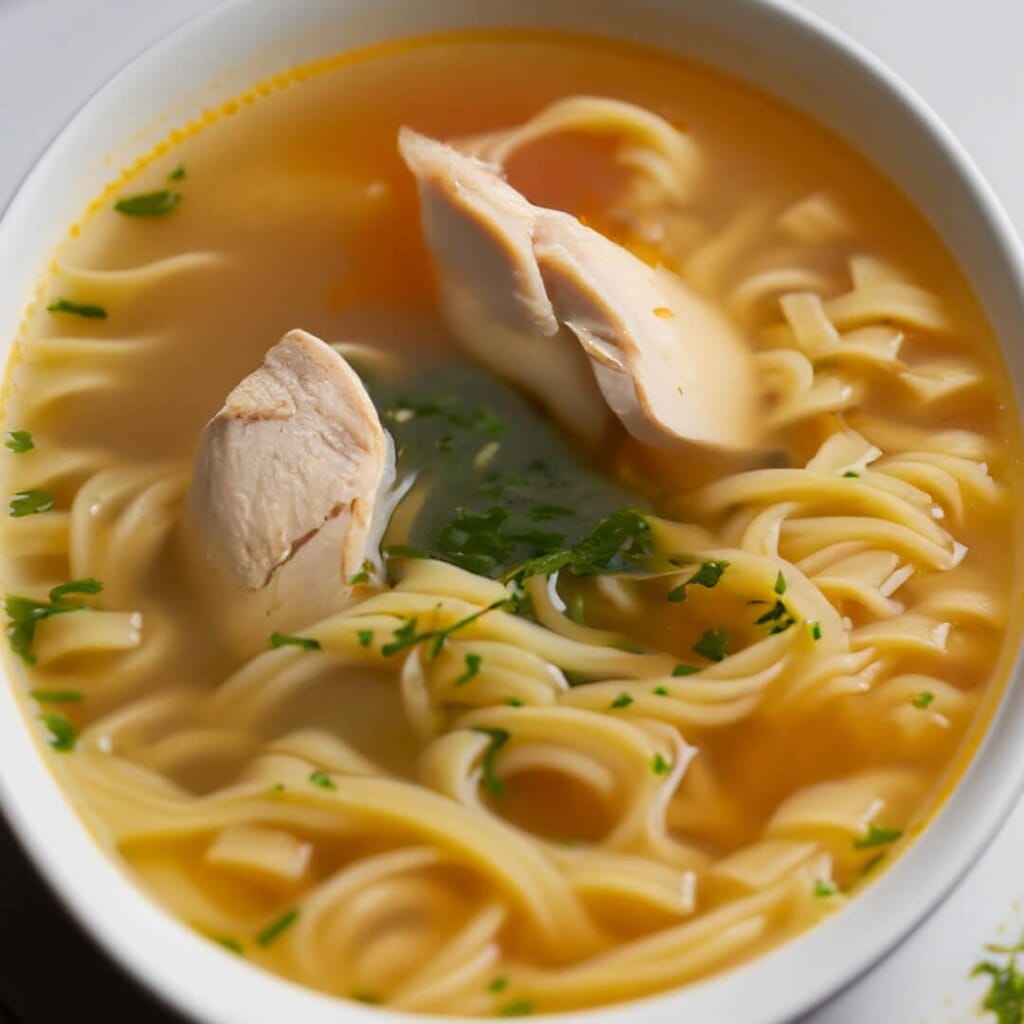
Nutritional Values
Chicken noodle soup isn’t just comfort food. It’s a nutritional powerhouse. Each spoonful offers a balanced blend of essential nutrients packed with lean protein from chicken, vitamins from fresh vegetables, and energy from noodles. Dive deeper to understand the wholesome values of this beloved dish.
What Are The Total Calories In The Soup?
Calculating the exact amount has many factors and variations. But if you are following the same ingredients in this recipe, then it will give an average calories of 250 to 350 per serving. However, the exact amount can be calculated by using a proper calorie counter and fitting with accurate ingredients.
Dietary Restrictions Of The Chicken Noodle Soup
- Gluten: Traditional egg noodles contain gluten. Those with celiac disease or gluten sensitivities should seek gluten-free alternatives.
- Meat: The soup is unsuitable for vegetarians and vegans due to the chicken and often the broth.
- Dairy: While most recipes are dairy-free, some variations may add butter or cream.
- High Sodium: Store-bought broths can be high in salt. Opt for low-sodium versions or make homemade.
- Allergens: Some might be allergic to ingredients like eggs in the noodles.
- Dietary Protocols: Not compliant with strict vegan, vegetarian, or other diet regimens.
Health Benefits Of The Chicken Noodle Soup
- Hydration: Its broth helps replenish fluids and electrolytes.
- Immune Boost: Chicken contains amino acids like cysteine, which helps thin mucus in the lungs.
- Nutrient Dense: Vegetables add essential vitamins and minerals.
- Muscle Health: Chicken provides high-quality protein necessary for muscle repair and growth.
- Digestive Health: Broth can aid in digestion due to gelatin from bones.
- Joint Health: Gelatin and other compounds from bone broth may support joint health.
- Comfort: The warm soup can soothe the throat and provide comfort during illness.
- Low Calorie: Generally, it’s a lower-calorie option that satiates.
Nutrition Table
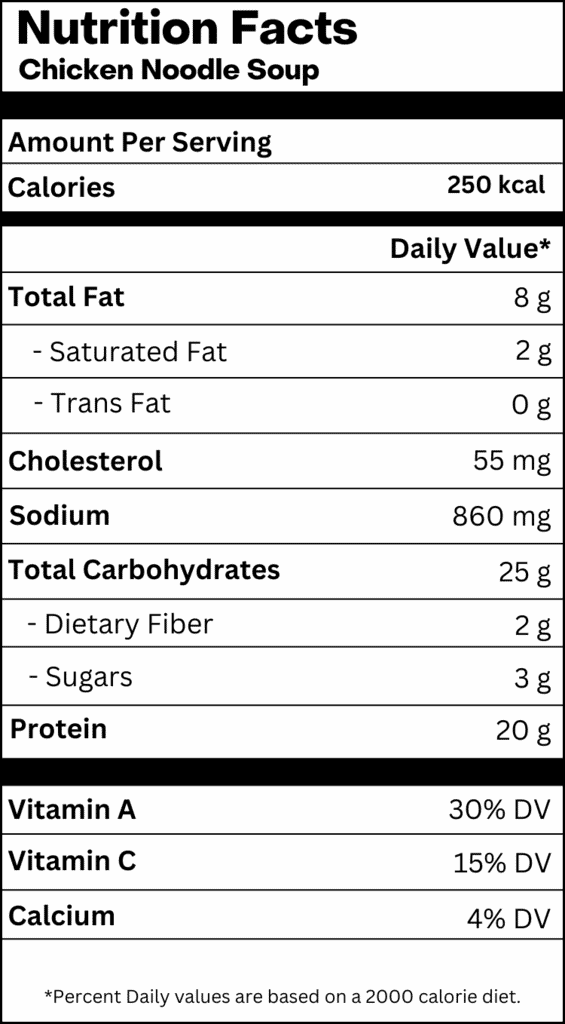
How Can I Make Chicken Noodle Soup Lower In Sodium?
- Homemade Broth: Start with a homemade broth using fresh chicken and vegetables. This allows you to control the salt content.
- Low-Sodium Store-Bought Broth: Choose a low-sodium or unsalted version if using store-bought.
- Fresh Ingredients: Processed or canned ingredients often contain added sodium. Opt for fresh vegetables.
- Limit Added Salt: Be cautious when seasoning; use herbs and spices for flavor instead.
- Alternative Seasonings: Lemon juice, vinegar, or unsalted herb blends can enhance flavor without adding sodium.
- Rinse Canned Goods: If using canned vegetables, rinse them thoroughly to wash away excess salt.
- Taste As You Go: Adjust seasonings gradually, tasting frequently to ensure flavor without over-salting.
How Can I Make Chicken Noodle Soup Lower In Sugar?
- Check Broth: Opt for unsweetened or low-sugar broths, as some store-bought versions may contain added sugars.
- Avoid Canned Ingredients: Some canned vegetables come in syrups or brines with sugar. Use fresh or frozen alternatives.
- Natural Flavor Enhancers: Rely on herbs, spices, and natural aromatics like garlic and onions instead of sauce mixes which might contain sugar.
- Monitor Carrots: While a natural ingredient, carrots are sweet. Adjust the quantity or choose less sweet vegetables.
- Read Labels: Always check for hidden sugars using any packaged ingredients.
- Homemade Always Wins: Making soup from scratch ensures you control every ingredient.
- Limit Sugar Alternatives: Even “natural” sweeteners can affect blood sugar. Use sparingly or skip.
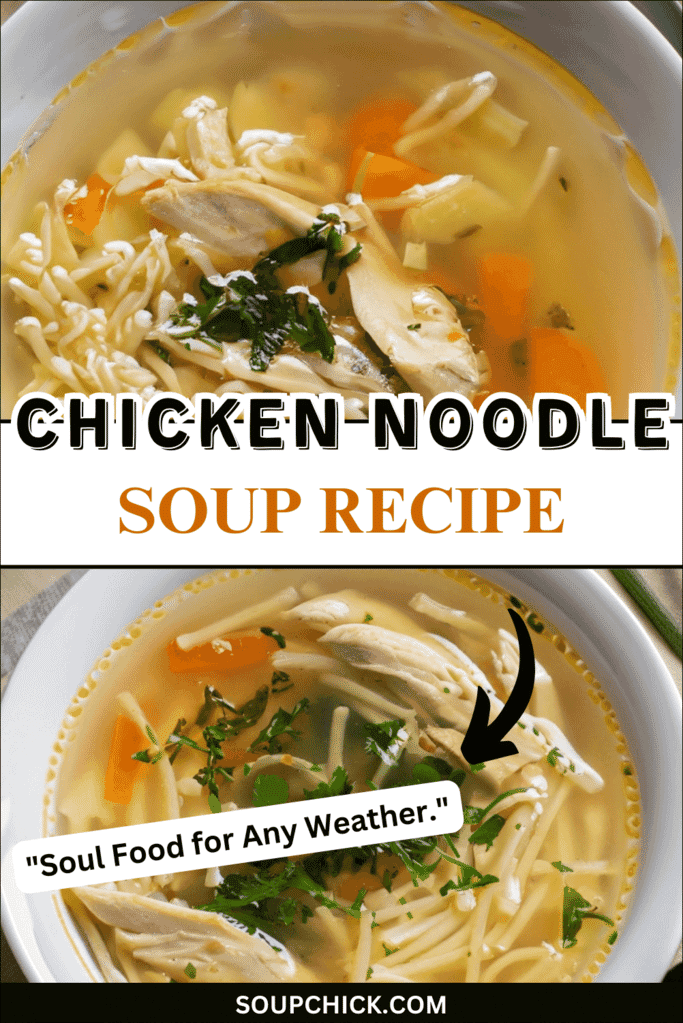
How To Serve The Chicken Noodle Soup At Its Best?
- Warm Bowls: Pre-warm serving bowls to keep the soup hot longer.
- Fresh Herbs: Garnish with chopped parsley, dill, or chives for a new flavor.
- Lemon Wedge: A squeeze can elevate the soup’s taste, adding brightness.
- Crusty Bread: Serve with a slice of fresh, warm bread or a roll to soak up the broth.
- Grated Cheese: A sprinkle of Parmesan or Pecorino can add depth.
- Adjust Seasoning: For individual adjustments, have salt, pepper, and red pepper flakes on hand.
- Serve Promptly: Best enjoyed hot, so serve immediately after cooking.
- Complementary Sides: A green salad or steamed vegetables can complete the meal.
Perfect Side Dishes To Compliment Chicken Noodle Soup
- Crusty Bread: Freshly baked baguettes or sourdough are ideal for dipping.
- Green Salad: A light salad with vinaigrette contrasts the soup’s warmth.
- Grilled Cheese Sandwich: A gooey, crispy classic that pairs perfectly.
- Steamed or Roasted Vegetables: Seasonal veggies add nutrition and variety.
- Quiche: A warm, savory quiche complements the soup’s texture.
- Bruschetta: Fresh tomatoes, basil, and garlic on toasted bread add a refreshing touch.
- Pita and Hummus: A Mediterranean touch for added protein.
- Fruit Salad: Light and sweet, it offers a contrasting flavor.
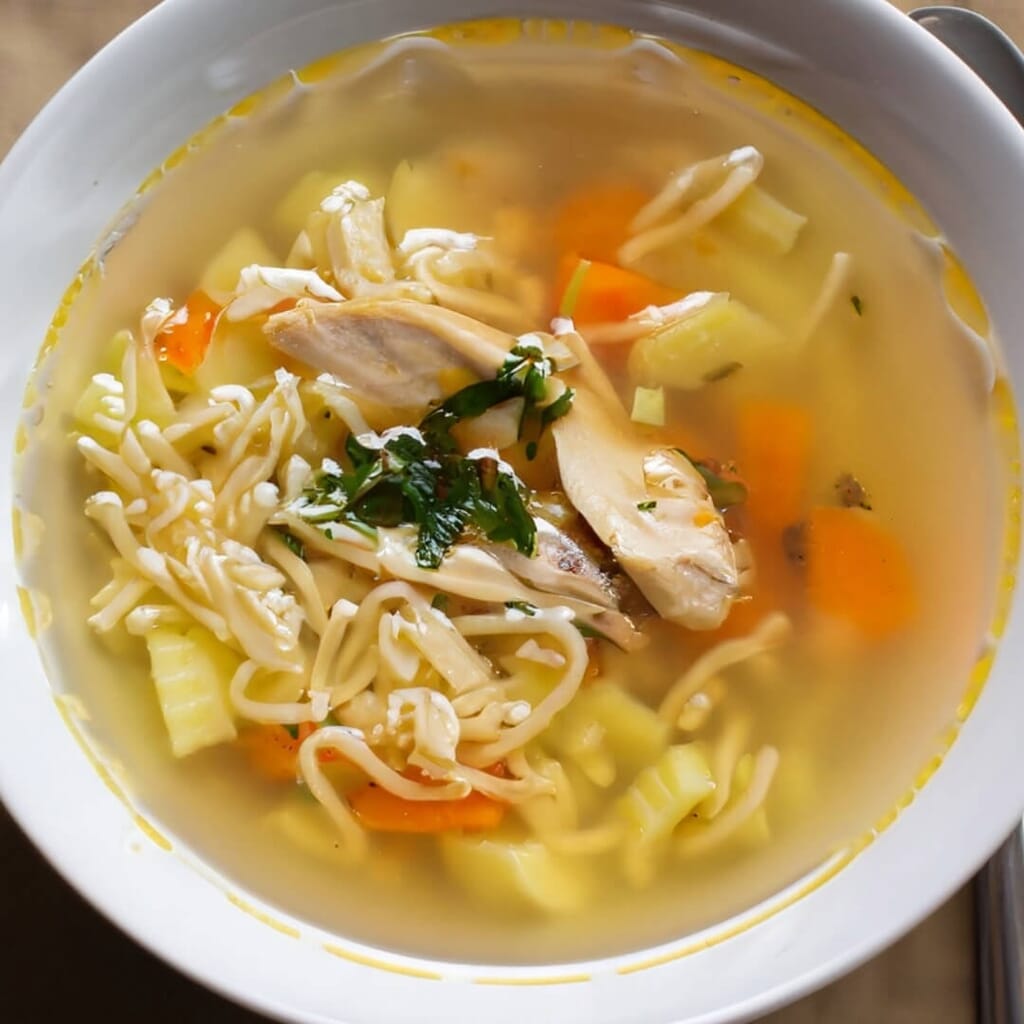
How Long Can We Store The Soup?
- Refrigeration: Store the soup in an airtight container. It will remain suitable for 3-4 days in the refrigerator.
- Freezing: For longer storage, freeze the soup. Ideally, skip adding the noodles before freezing, as they can become mushy when reheated. Soup can last 4-6 months in the freezer.
- Reheating: Always reheat to a boil, ensuring it’s thoroughly hot throughout before serving.
- Cool Before Storing: Allow the soup to cool to room temperature before refrigerating or freezing, but don’t leave it for 2 hours.
Can I Make The Soup In Advance?
- Cook Fully: Prepare the entire soup but consider leaving out noodles, as they can get mushy.
- Cool Quickly: Speed up the cooling process by placing the pot in an ice bath, stirring occasionally.
- Store: Transfer to an airtight container and refrigerate.
- Reheat: Warm on the stove, adding any reserved ingredients like noodles.
- Serve: Once thoroughly heated, serve immediately.
What Can We Do With Leftovers?
- Chicken Salad: Shred the chicken, mix it with mayonnaise, and add fresh veggies for a quick salad.
- Casserole Base: Use the soup as a base for a casserole, topping with breadcrumbs and cheese.
- Stir Fry: Drain the liquid and stir the leftover chicken and vegetables with sauce.
- Rice Dish: Mix with cooked rice, creating a comforting pilaf or risotto.
- Fritters: Combine ingredients, form into patties, and pan-fry.
- Broth Bowls: Add fresh veggies, proteins, or grains to the broth for a new soup.
- Pasta Sauce: Reduce the broth and serve over pasta.
- Tacos or Wraps: Use the chicken and veggies as fillings.
- Pot Pies: Use leftovers as a filling for a delicious pot pie.
- Pizza Topping: Shred the chicken and scatter it on the pizza with other complementary toppings.
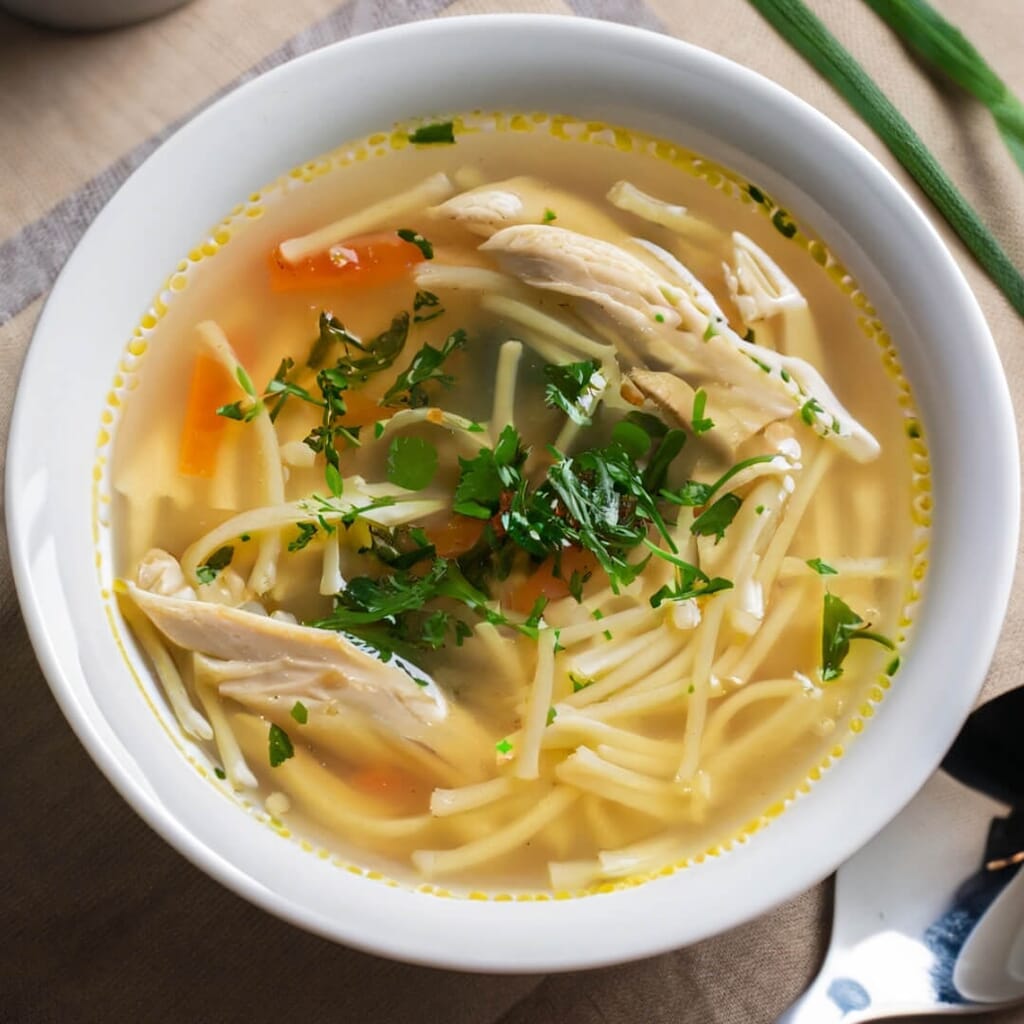
Special Tools/Equipment Needed
- Large Pot: Essential for making a substantial batch of soup and ensuring even cooking.
- Sharp Knife: For precise cutting of chicken and chopping vegetables.
- Cutting Board: Preferably two – one for raw chicken and another for vegetables to prevent cross-contamination.
- Wooden Spoon: Useful for stirring, ensuring ingredients don’t stick to the pot’s base.
- Ladle: For serving soup without spills.
- Fine-Mesh Strainer: Making broth from scratch helps separate solids from the liquid.
- Measuring Cups and Spoons: Ensure accurate ingredient quantities.
- Thermometer: To check if the chicken has reached a safe internal temperature.
- Storage Containers: For storing leftovers or any unused broth.
- Soup Bowls: Deep bowls help retain the soup’s warmth.
Final Thoughts
And that’s it! Chicken noodle soup is easy to make once you have the right ingredients.
All of the ingredients we have chosen to include in this recipe have been specially selected to help capture that delicious nostalgic feeling of grandma’s chicken noodle soup.
We hope this guide has helped you feel ready to try making your batch of grandma’s chicken noodle soup. We hope it tastes as good as it did when you were a kid! Enjoy and happy cooking!
Frequently Asked Questions
What Sides Can You Serve With Grandma’s Chicken Noodle Soup?
Most people enjoy chicken noodle soup as a hearty lunch, especially when feeling sick or unwell.
As a result, most people eat chicken noodle soup without any side dishes. However, there are still lots of things that pair well with chicken noodle soup.
You can’t go wrong with delicious French bread or plain dinner rolls if you want a light side. These are great for soaking up the soup’s liquid, so you get to enjoy every drop!
Saltine crackers are a good alternative, or grilled cheese if you are looking for a more filling side.
You can also try some biscuits, mashed potatoes, cornbread – any side that can help you soak up the soup’s liquid!
How Should You Store Grandma’s Chicken Noodle Soup Leftovers?
If you have any leftovers from your chicken noodle soup, you don’t need to throw them out and let all your hard work go to waste. You can easily store your leftover chicken noodle soup for another day!
All you need to do is store it in an airtight container and a refrigerator. If you don’t have an airtight container, transfer your leftovers into a large dish and cover it with plastic wrap.
Ensure the wrap is as tight as possible to help seal the soup inside and keep out any air.
This will keep your chicken noodle soup good for a few days. Make sure you reheat your soup before serving!
If you want to store your leftovers longer, pop them in the freezer instead. Freezing your leftovers will keep them good to eat for a few months!
How Can I Ensure My Chicken Is Thoroughly Cooked Without Overcooking The Vegetables?
A prudent approach would be to add chicken pieces first, allowing them a head start in cooking. Once they’re nearly done, introduce the vegetables. This ensures the chicken is thoroughly cooked while keeping vegetables crisp.
Is There A Recommended Herb Blend For The Chicken Noodle Soup?
A classic blend would include thyme, bay leaf, and parsley. Nonetheless, including herbs are subjective, and you can adjust based on personal preferences. Fresh herbs add a brighter flavor toward the end of cooking.
How Can I Make My Chicken Noodle Soup Creamier Without Adding Cream?
An orthodox method involves puréeing a portion of the cooked vegetables and reintroducing them into the soup. This adds body and creaminess without the need for dairy. Another alternative is incorporating a roux—a butter and flour mixture—to thicken the broth.
- How To Make Butternut Squash Soup Recipe – Easy And Delicious - February 13, 2024
- Perfect Chinese Chicken Soup Recipe – A Delightful Feast - October 3, 2023
- Easy Red Pepper Soup Recipe (Sweet-Mild Flavors) - October 3, 2023

